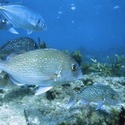Being able to adapt is a matter of life or death. In a perfect world, organisms would not need to adapt. However, changes to the environment and food web mean that organisms need to move, if they can, adapt or become extinct.
Adaptation
Adaptation is a trait that enables an organism to live in its environment. Adaption occurs in three ways:
- Behavioural adaptation relates to the behaviour of the organism. For example, fish swim in schools or large numbers to protect members of the group from predators.
- Structural adaptation relates to the organism’s physical features. For example, many bivalve (two shells) molluscs have specific structures, such as siphons, gills and cilia that allow them to filter out food.
- Physiological adaptation relates to how an organism’s metabolism works. For example, some soft-bodied sea animals excrete chemicals as a defence mechanism.
Behavioural adaptation happens more quickly than structural or physiological adaptation. The more intelligent an animal is, the faster it can learn to make behavioural changes in order to survive. However, structural and physiological adaptations require genetic change, which can only occur through mutation or other gene changes over several generations. The article Marine organisms and adaptations provides additional information about these categories.
The following are some examples of adaptations of organisms within habitats found in marine environments like the Bay of Plenty.
Adapting to estuaries
Estuaries are where freshwater from the land mixes with saltwater from the sea. Consequently, the salinity levels of the water change over the tidal cycle. Plants and animals living in estuaries must be able to respond quickly to drastic changes in salinity. Organisms that are capable of dealing with varying salinities are euryhaline (like mangroves), and organisms that can only deal with small changes in salinity are stenohaline. Stenohaline animals rely on behavioural adaptations such as moving out of the area, burrowing in the sand and closing their shells or physiological adaptations such as excreting excess salts. Worms, molluscs and fish can produce mucus or slime to cover sensitive body parts.
Some marine animals have evolved interesting ways to survive the challenges in estuaries. For example, mud snails (tītiko) are like gardeners. They suck in and excrete mud, ploughing it up and improving its properties so that plants grow more easily. These are the plants the snails then feed on.
Marine bristleworms or polychaetes use their fine bristles for swimming and holding themselves in their burrows. Some make ‘shells’ for protection. These shells are tubes made of sand and shell segments held together with a sticky secretion.
Adapting to beaches
Beach habitats are an extremely dynamic environment where sand, water and air are always in motion. Surf beaches are particularly dynamic. The burrowing of animals must be rapid and powerful so that the animals are not swept away by incoming waves and swash (turbulent water movement). Desiccation (drying out) is not a concern to these animals because they can retreat into the substratum (well below the initial layer of sand) or below the water table.
Bivalves such as tuatua tend to live along the beaches. To avoid predation, they can burrow deeply into the sand or migrate on the tide to a different area.
Paddle crabs use the paddles on their rear legs to burrow into the sand for protection, with only their eyes and antennae protruding. They also use their paddles for swimming. They forage for food at night, often predating on tuatua and other shellfish.
Adapting to rocky shores
Desiccation threatens animals living in intertidal zones on the rocky shore. Some adaptive features include migration to an underwater area (if they are mobile), restricting activities (reduced metabolism) and attaching more firmly to the rocks along with resistant shells and the ability to retain water.
Molluscs on the rocky shore are mostly univalved (one shell). They cannot burrow into sand like the bivalves for safety so they have very strong shells with an operculum (trapdoor attached to the foot muscle). Limpets are a good example of this. They are particularly well adapted for life on rocky surfaces. Every limpet has a ‘home’ spot on a rock. This is the place they stay when the tide is out. On soft rock, the limpet grinds it with its shell to make an exact fit. On hard rock, the shell is ground down to fit the rock’s shape. The tight fit allows the limpet to trap some water inside its shell to stop it drying out. It has a strong foot muscle that grips onto the rock – making it difficult for birds to prise it off.
Dog whelks are active predators. They have special drilling mouth parts used to bore through the shells of other molluscs such as limpets and barnacles. They can also produce a shell-dissolving acid to help them reach inside the shell. They then suck up the flesh.
Activity ideas
In the activity, Where do I live? students learn about the characteristics of three marine habitats (harbour, surf beach and rocky shore) and match plants and animals with each habitat, according to their adaptive features.
The activity Labelling a cockle/tuangi uses the interactive Label the cockle/tuangi to explore some of the structures of this common marine bivalve. The activity provides an excellent opportunity to discuss structural adaptations.









